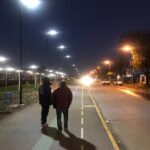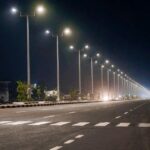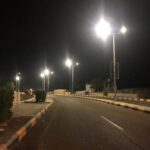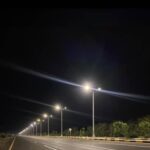Welcome to the illuminating journey towards crafting a compelling Solar Street Light Proposal! In this dynamic era of sustainable solutions, harnessing the power of the sun for street lighting is both visionary and eco-friendly. As you embark on this venture, it’s paramount to delve into the intricacies that make your proposal shine. So, let’s dive in and discover how these key elements can transform your vision into a sustainable reality.
solar street light project proposal
The Vital Components of a Comprehensive Solar Street Light Proposal
What should you include in your proposal to ensure success?
Project Objectives
In any comprehensive solar street light proposal, project objectives stand tall as a crucial cornerstone, outlining the very essence and purpose of the endeavor. These objectives should include;
- Craft the objectives with precision, clearly defining the purpose of the solar street light project. Make it explicit and align it with the needs of the community.
- Project Objectives should be quantifiable, allowing for precise measurement of success. Have measurable goals that provide a tangible framework for evaluation.
- Establish a timeline for achieving each objective. Setting specific deadlines creates a sense of urgency and accountability.
- Consider the expectations of key stakeholders, be it the local community, government bodies, or environmental organizations. Ensure that the objectives resonate with their needs and contribute positively to their interests.
- Incorporate objectives related to technological advancements. Stay at the forefront of technological progress to maximize the project’s impact.
- Incorporate objectives that encourage continuous improvement. Whether through regular performance evaluations, feedback mechanisms, or adaptation to emerging technologies.
- Consider scalability and replicability in your objectives. If successful, can this project serve as a model for other communities?
Project Scope
The project scope stands out as a crucial component, defining the boundaries, objectives, and deliverables of the initiative. It plays a pivotal role in guiding project planning, execution, and evaluation. You should outline the specific solar street light system to be installed, detail the technical specifications, such as the type and wattage of solar panels, the capacity of the battery storage, and the efficiency of LED fixtures. Clearly delineate the geographical extent of the installation, and specify the number of streetlights and their proposed locations.
Moreover, the project scope explicitly states the goals and benefits to be achieved, emphasizing aspects like energy efficiency, environmental sustainability, and community safety. It establishes measurable performance indicators to assess the success of the solar street light implementation, ensuring accountability and transparency throughout the project lifecycle.
In addition, the scope addresses the project timeline, milestones, and any potential risks that may impact successful completion. It serves as a foundational document, aligning stakeholders’ expectations and providing a comprehensive understanding of the project’s scale and impact.
Technical Specifications
Technical specifications of a solar street light proposal form the backbone of the project, delineating the performance, efficiency, and reliability of the proposed solar lighting system. The primary technical specifications encompass the solar panels, batteries, LED luminaires, and control systems. Solar panels, critical in harnessing solar energy, should be specified in terms of wattage, efficiency, and durability. Optimal battery capacity, type, and lifespan must be clearly defined to ensure seamless energy storage and supply during periods of low sunlight.
The LED luminaires’ technical details, including wattage, color temperature, and luminous flux, are imperative for determining the system’s illumination capabilities. Additionally, specifying the control system, such as the type of sensors and programmable features, ensures efficient energy management and responsive operation based on environmental conditions.
Primary solar street light technical specifications
Financial Analysis
It serves as a cornerstone for assessing the economic viability and sustainability of the proposed solar street lighting project. Firstly, an in-depth financial analysis allows stakeholders to determine the initial investment required for the installation of solar street lights. This includes the cost of solar panels, lighting fixtures, batteries, poles, and other necessary components. By itemizing these expenses, project managers can present a transparent breakdown of the budget, fostering trust and confidence among investors and decision-makers.
Furthermore, the financial analysis evaluates the operational costs associated with maintaining and running the solar street lights over their lifecycle. This encompasses expenses related to routine maintenance, replacements, and energy consumption. By quantifying these ongoing costs, the proposal provides a realistic projection of the total cost of ownership, aiding in long-term budget planning.
Return on Investment (ROI) is another crucial aspect illuminated by the financial analysis. By forecasting the savings accrued through reduced electricity bills and lower maintenance costs over time, stakeholders can gauge the project’s profitability. Expressing these potential returns in clear financial terms enhances the persuasiveness of the proposal, making a compelling case for the economic benefits of investing in solar street lighting.
Moreover, financial analysis considers potential sources of funding, such as government incentives, grants, or subsidies for renewable energy projects. Identifying and quantifying these financial incentives strengthens the proposal by showcasing external support and minimizing financial risks for stakeholders.
Environmental Impact
It’s crucial to highlight the environmental impact as a key component of your solar street light proposal. Emphasizing the positive effects of this sustainable solution will not only resonate with stakeholders but also underscore the project’s broader contribution to environmental well-being. Include advantages such as;
- Demonstrate how solar street lights being powered by clean and renewable solar energy, significantly reduce reliance on traditional power sources.
- Highlight the carbon footprint reduction associated with solar street lights.
- Explain how solar street lights play a pivotal role in mitigating climate change by minimizing the release of harmful greenhouse gases.
- Address the environmental advantages of minimal infrastructure disruption.
- Emphasize the longevity and low maintenance of solar street lights. Explain how solar street light’s durability and minimal upkeep aspects provide cost savings.
Community Benefits
It’s vital to highlight the community benefits as a central component of your solar street light proposal. By doing so, you not only emphasize the positive impact on the residents but also make a compelling case for the broader societal advantages Some of these benefits include;
- Enhanced Safety and Security: solar street lights improve safety by providing well-lit public spaces, reducing the risk of accidents and criminal activities. Active solar lighting fosters a sense of security among community members, promoting nighttime visibility and overall well-being.
- Social and Economic Development: Solar street lights contribute to the community’s economic development by creating local job opportunities during installation and maintenance phases.
- Extended Access to Public Spaces: Well-lit streets encourage community members to utilize public spaces during evening hours. Parks, walkways, and recreational areas become more accessible, promoting social interaction and a sense of community cohesion.
- Environmental Awareness and Education: Integrating solar technology into public spaces offers an opportunity for community education on renewable energy. Informational sessions or displays can be incorporated into the proposal, fostering environmental awareness and encouraging sustainable practices within the community.
- Reduced Energy Costs for the Community: Solar street lights contribute to overall energy cost reduction for the community. By harnessing sunlight, these lights alleviate the burden on the traditional power grid, leading to long-term cost savings.
Stakeholder Engagement
Start by clearly identifying and categorizing your stakeholders. This includes local government bodies, community members, businesses, environmental groups, and any other entities that may be affected or have an interest in your solar street light project. Understanding their perspectives and needs is fundamental. Initiate proactive communication with these stakeholders to garner their input early in the proposal process. This could involve hosting community meetings, conducting surveys, or arranging one-on-one discussions. The goal is to gather insights, address concerns, and incorporate valuable feedback into your proposal.
Highlight the benefits of the solar street light project, not just in terms of energy efficiency but also in terms of community safety, economic development, and environmental impact. Tailor your messaging to resonate with each stakeholder group, showcasing how the project aligns with their interests and priorities.
Clearly outline the measures you’ll take to address any potential challenges or concerns raised by stakeholders. This might involve implementing specific design features, establishing a community liaison, or providing ongoing updates and opportunities for feedback. Demonstrate a commitment to transparency and accountability. Clearly articulate the decision-making process and how stakeholders will be kept informed throughout the different project phases.
Incorporate mechanisms for ongoing engagement beyond the initial proposal phase. This could include regular community meetings, progress reports, and avenues for stakeholders to voice their opinions as the project evolves.
Implementation Plan
It’s imperative to articulate a well-defined implementation plan in your solar street light proposal. This component outlines the step-by-step process to seamlessly integrate solar street lights into the designated area. You can include things like;
- Site Assessment: Begin by conducting a thorough site assessment. Identify key parameters such as geographical location, sunlight exposure, and surrounding infrastructure.
- Technology Selection: Clearly specify the solar street light technology you propose to use. Outline the efficiency, durability, and sustainability features of the chosen technology.
- Detailed Installation Plan: Break down the installation process into specific steps. Include details on the equipment required, installation timeline, and any potential challenges that may arise during installation. Provide a clear and concise roadmap for executing the installation.
- Quality Control Measures: Describe how you will monitor and evaluate the installation process to guarantee that all systems are functioning optimally.
- Training and Maintenance: Devise a plan for training personnel responsible for the ongoing maintenance of the solar street lights. Clearly articulate how routine maintenance activities will be conducted.
- Monitoring and Evaluation: Define a monitoring and evaluation framework to assess the effectiveness of the solar street lights post-installation.
Maintenance Plan
Include a detailed schedule outlining routine maintenance tasks. Specify the frequency of inspections, such as monthly, quarterly, and annually, and clearly state the responsibilities of the maintenance personnel. For instance, monthly checks might involve cleaning solar panels and inspecting wiring, while quarterly inspections could focus on battery performance and connections. Highlight the importance of regular performance evaluations. Clearly articulate the parameters to be assessed during these evaluations, such as battery voltage, solar panel efficiency, and overall system functionality.
Incorporate a contingency plan within the maintenance proposal. Outline the steps to be taken in case of system malfunctions, unexpected breakdowns, or extreme weather events. This could involve a rapid response team, a designated emergency contact, and readily available spare parts to minimize downtime. Emphasize the significance of staff training in the maintenance plan. Ensure that personnel responsible for upkeep are well-trained on troubleshooting techniques and equipped with the necessary tools. This not only enhances the efficiency of the maintenance process but also contributes to cost-effectiveness in the long run.
Consider incorporating a predictive maintenance approach, utilizing monitoring systems and advanced analytics. This allows for the identification of potential issues based on data trends, enabling proactive measures to be taken before a failure occurs. Highlighting this modern approach demonstrates a commitment to cutting-edge technology and efficient resource management.
Risk Assessment
Incorporating a robust risk assessment is a vital element in developing a comprehensive solar street light proposal. This proactive approach not only safeguards the integrity of the project but also serves as a testament to your dedication to delivering a successful and sustainable solution.
To begin, meticulously identify potential risks associated with the installation, operation, and maintenance of the solar street lights. These risks may range from environmental factors and equipment malfunctions to regulatory challenges. By actively recognizing these potential obstacles, you empower yourself to devise effective mitigation strategies.
Clearly outline each identified risk, assessing its potential impact on the project timeline, budget, and overall success. Concurrently, propose concrete measures to mitigate or manage these risks, demonstrating foresight and a commitment to overcoming challenges.
By taking a proactive stance on risk assessment, you not only showcase your diligence but also instill confidence in stakeholders regarding your ability to navigate unforeseen circumstances. This comprehensive approach significantly contributes to the overall strength and viability of our solar street light proposal.
Conclusion
Developing a solar street light proposal is undoubtedly a formidable undertaking. The creation of a thorough and impactful proposal necessitates meticulous attention to a multitude of factors, and we have diligently addressed the key considerations. Our intent in presenting this information is to aid you in your venture. We trust that this proposal has been a valuable guide in navigating the intricacies of solar street light projects. Do you have any questions? Reach out!



















